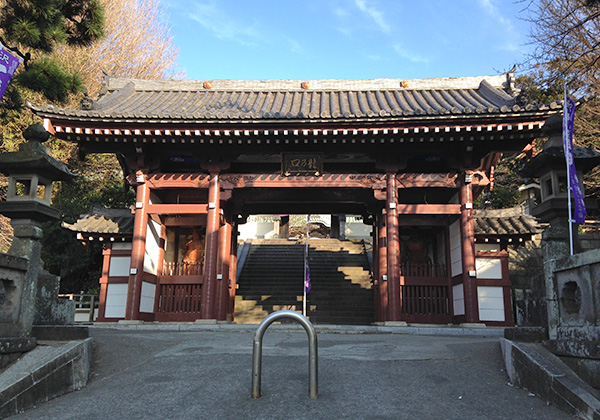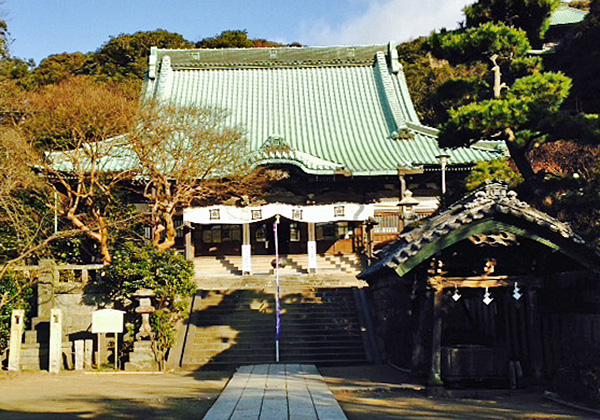Ryukoji
| Official Name | Jakkozan Ryukoji {Pronounced jack-koh-zan ryu-koh-gee} |
|---|---|
| Religious sect | Nichiren Sect, Buddhism |
| Founded | in 1337 by Priest Nippo {nip-poh} |
| Founding priest | Nippo |
| Main object of worship | Statues of Nichiren and Odaimoku {o-dye-mok} Tablet |
| Address | 13-37, Katase 3-chome, Fujisawa, Kanagawa 251-0032 (show route from current location ) |
| Location | 5,500 meters west of Kamakura Station |
| Time needed to get there | 70 minutes |
| Open | 9:00 - 16:00 |
| Phone number | 0466-25-7357 |
Historical Overview
The temple site used to be an execution ground for criminals during the Kamakura Period (1185-1333), and its monuments stand at the left-hand side of the Temple's outer gate.
Priest Nichiren (1222-1282), the founder of the Nichiren Sect, stayed in Kamakura for nearly 20 years and was engaged in missionary work for Buddhism, emphasizing the importance of the Lotus Sutra. His adoration to the Lotus Sutra was so intense that he constantly attacked other sect doctrines criticizing them as heretical, or dissent from right Buddhism, which provoked hostility toward him not only from other sect Buddhists but also from the government authorities. During his stay in Kamakura, he had to face such persecutions four times and in the last case of 1271, he was sentenced to death (by beheading) as he accused the government of not employing his doctrines.
On September 12, 1271, Priest Nichiren was brought here for the execution. No one doubted he would die within hours. However, the moment an executioner was about to strike down his sword to behead him, asserts the legend, a tremendous clap of thunder roared the area with a streak of lightning. Aghast and petrified, the executioner was no longer able to behead the Priest. He thought it was a miracle wrought by the Priest. (the Priest performed a various miracles and was revered as a miracle worker by millions like beautified Christian saints.) Messengers were sent to the government office to tell them what happened. When they came up to a stream called the Yukiai {yoo-key-eye} River, roughly 2,000-meter east of the Temple, they met with another messengers who were dispatched by Tokimune Hojo {toh-key-moo-neh hoh-joe} (1251-1284), then the Eighth Regent. The government messengers were on the way to tell them not to execute Priest Nichiren. Since the two groups met here by accident, the river was thus named the "Yukiai-gawa" or the River of Meeting.
The execution was suspended immediately and Priest Nichiren was exiled instead to an island off the coast of Niigata Prefecture. (Some say that the Regent gave a special pardon to Priest Nichiren as the Regent's wife turned out to be pregnant)
Sixty-six years later on this historic spot, a priest named Nippo, Priest Nichiren's adherent, made a hermitage to dedicate it to the memory of the great Priest, in which he enshrined a statue of Priest Nichiren he carved himself. From then on, the Temple gradually gained momentum supported by the devout and expanded its structures.
However, the Great Kanto Earthquake in 1923 destroyed almost all of the Temple structures except the main hall and the five-story pagoda. All others were rebuilt afterward.
Ryukoji ranks among the 44 head temples of Nichiren sect.

Hondo or Main Hall {also called shikigawa-do {she-key-gah-wah-doe}

The present hall, 29 by 32 meters, was rebuilt in 1818 and one of the largest in Kamakura. shikigawa means a leather mat on which Priest Nichiren sat waiting for the execution. Since Priest Nippo erected the original hermitage, it has been called shikigawa-do. Today, the stone on which shikigawa was laid is kept at the center-left of the hall as a temple treasure. In contrast to other sect temples like Zen, inside the hall of Nichiren sect temples is highly decorative ornamented with many carvings and decorations hanging down from the ceiling.
In the center are a group of statues and the Odaimoku Tablet inscribed with the letter "Nam-myo-ho-ren-gek'kyo", often seen at other Nichiren Sect temples. In the right-hand recess are six statues of those who were Priest Nichiren's immediate disciples. Unlike other Nichiren sect temples, the door is usually open and casual visitors are allowed to go into the hall, even get close to the statues if religious services are not held.

